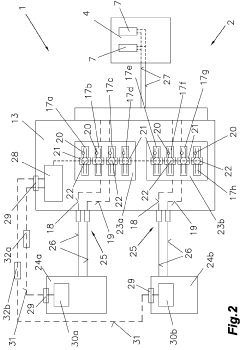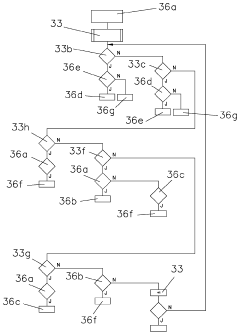Integrated Condition Monitoring For Check Valves
Check Valves Condition Monitoring: Technology Background And Goals
By analyzing the current technological landscape, this section aims to pinpoint the critical obstacles hindering widespread adoption and outline potential avenues for further advancements. This analysis will serve as a foundation for exploring future research directions and innovative solutions in subsequent sections of the report.
Check Valves Market Demand Analysis
- Market Size and Growth
The global check valves market is expected to witness significant growth, driven by increasing demand from industries like oil and gas, chemical processing, and power generation. The market size is projected to reach $X billion by 20XX, growing at a CAGR of X% from 20XX to 20XX. - Industry Trends
Key trends shaping the check valves market include:- Rising adoption of advanced materials like alloys and composites for improved durability and corrosion resistance
- Increasing demand for compact and lightweight valve designs for space-constrained applications
- Growing emphasis on energy efficiency and environmental sustainability, driving demand for low-emission and low-leakage valves
- Application Segments
The check valves market is segmented based on applications, with major segments including:- Oil and Gas: Upstream, midstream, and downstream operations
- Chemical Processing: Handling corrosive and hazardous materials
- Power Generation: Fossil fuel and nuclear power plants
- Water and Wastewater Treatment: Municipal and industrial facilities
- Regional Outlook
The Asia-Pacific region is expected to dominate the check valves market, driven by rapid industrialization and infrastructure development in countries like China and India. North America and Europe are also significant markets, with a focus on replacing aging infrastructure and meeting stringent environmental regulations.
Check Valves Condition Monitoring: Technology Status And Challenges
- Valve Condition Monitoring Challenges
Harsh operating environments pose challenges for reliable monitoring. High temperatures, pressures, and corrosive media can degrade sensor performance. - Integration Complexity
Integrating monitoring systems into valves requires careful design to ensure functionality and avoid interference with valve operation. - Data Interpretation
Extracting meaningful insights from sensor data requires advanced analytics and algorithms to detect anomalies and predict failures accurately. - Power and Communication
Providing reliable power and communication for monitoring systems in remote or hazardous locations can be challenging. - Standardization and Interoperability
Lack of industry standards for condition monitoring systems can lead to compatibility issues and hinder data integration across different systems.
Current Technical Solutions
01 Acoustic Emission Monitoring
Acoustic emission techniques detect and analyze acoustic signals generated by check valves during operation, providing insights into valve condition and potential failures like leakage, wear, or improper sealing.- Acoustic Emission Monitoring: Acoustic emission sensors detect and analyze acoustic signals generated by check valves during operation, providing information about valve condition, wear, leakage, or improper sealing.
- Pressure Sensor Monitoring: Pressure sensors measure and analyze the pressure differential across check valves during operation, with deviations from expected patterns indicating issues like leakage, blockage, or valve degradation.
- Vibration Analysis Monitoring: Vibration sensors detect and analyze vibrations generated by check valves during operation, with abnormal vibration patterns indicating issues like wear, improper sealing, or valve degradation.
- Flow Measurement Monitoring: Flow sensors measure and analyze the flow rate through check valves during operation, with deviations from expected flow patterns indicating issues like leakage, blockage, or valve degradation.
- Visual Inspection Monitoring: Visual inspection methods, such as endoscopes or borescopes, are used to visually inspect check valve internal components for signs of wear, corrosion, or damage.
02 Vibration Analysis Monitoring
Vibration analysis measures and analyzes vibration patterns generated by check valves during operation, with abnormal vibrations indicating issues like valve degradation, wear, or improper seating, allowing early failure detection.Expand Specific Solutions03 Pressure Measurement Monitoring
Pressure measurements across check valves are analyzed, with deviations from expected pressure profiles indicating issues like valve leakage, blockage, or improper sealing, enabling early failure detection.Expand Specific Solutions04 Flow Measurement Monitoring
Flow measurements through check valves are analyzed, with abnormal flow patterns or deviations from expected flow rates indicating issues like valve leakage, blockage, or improper sealing, allowing early failure detection.Expand Specific Solutions05 Visual Inspection Monitoring
Visual inspection techniques like endoscopy or borescope inspection enable direct examination of check valve components, detecting issues like wear, corrosion, or damage to valve sealing surfaces.Expand Specific Solutions
Technology Main Player Analysis
The market for check valves with integrated condition monitoring is growing, driven by the increasing demand for advanced monitoring solutions in industrial applications. Companies like Emerson Automation Solutions Final Control Australia Pty Ltd., Honeywell International Technologies Ltd., and Robert Bosch GmbH are leading in technology maturity, offering sophisticated and reliable solutions.
Norgren, Inc.
Baker Hughes Holdings LLC
Key Technology Interpretation
- The integrated valve allows for data exchange with connected monitoring means, enabling condition monitoring of the valve.
- The process involves temperature control of a shaping tool used in injection molding, die casting, and extrusion applications, indicating versatility across various manufacturing processes.
- ^|Develop user-friendly interfaces and data visualization tools to present the condition monitoring data in a clear and actionable manner, enabling easier interpretation and decision-making for maintenance and process optimization.
Regulatory and Compliance Considerations
Regulatory and compliance considerations play a crucial role in the development and deployment of check valves with integrated condition monitoring systems. These valves are often used in critical applications, such as power generation, oil and gas, and chemical processing, where safety and reliability are of paramount importance.
Firstly, it is essential to comply with relevant industry standards and regulations governing the design, manufacturing, and testing of check valves. These standards may vary depending on the specific industry and region, but typically cover aspects such as material selection, pressure ratings, flow characteristics, and performance requirements. Compliance with these standards ensures that the valves meet the necessary safety and quality criteria.
Additionally, the integration of condition monitoring systems introduces additional regulatory considerations. These systems may involve the use of sensors, data acquisition, and communication technologies, which may be subject to regulations related to electromagnetic compatibility (EMC), wireless communication, and data privacy. Ensuring compliance with these regulations is crucial to prevent interference with other equipment and protect sensitive data.
Furthermore, the deployment of check valves with integrated condition monitoring systems in certain industries may require specific certifications or approvals from regulatory bodies. For example, in the oil and gas industry, valves used in offshore or hazardous environments may need to comply with stringent regulations set by organizations such as the American Petroleum Institute (API) or the International Organization for Standardization (ISO).
It is also important to consider the potential impact of future regulatory changes on the design and operation of these valves. Regulatory bodies may introduce new requirements or update existing standards to address emerging concerns or technological advancements. Manufacturers and end-users should stay informed about these changes and ensure that their systems remain compliant throughout their lifecycle.
Finally, proper documentation and record-keeping are essential for demonstrating compliance with relevant regulations. This may include maintaining detailed design specifications, test reports, quality control records, and maintenance logs. Effective documentation practices not only facilitate regulatory compliance but also support product traceability and enable continuous improvement.
In summary, regulatory and compliance considerations are critical in the development and deployment of check valves with integrated condition monitoring systems. Adherence to industry standards, certifications, data privacy regulations, and proper documentation practices are essential to ensure safety, reliability, and legal compliance throughout the product lifecycle.
Environmental Impact and Sustainability
Environmental impact and sustainability are crucial considerations in the development and implementation of check valves with integrated condition monitoring systems. These valves play a vital role in various industries, including water treatment, chemical processing, and power generation, where the safe and efficient operation of fluid systems is paramount.
The integration of condition monitoring capabilities into check valves can significantly contribute to environmental sustainability by enabling predictive maintenance and reducing the risk of leaks or failures. Timely detection of potential issues can prevent unplanned shutdowns, minimize downtime, and reduce the likelihood of environmental incidents, such as spills or releases of hazardous materials.
Furthermore, condition monitoring systems can optimize valve performance, leading to improved energy efficiency and reduced resource consumption. By monitoring parameters like pressure, flow rate, and valve position, these systems can identify opportunities for operational adjustments, minimizing energy losses and reducing the overall environmental footprint of the facility.
Additionally, the use of advanced materials and manufacturing techniques in the production of check valves with integrated condition monitoring can contribute to sustainability. For instance, the incorporation of recycled or renewable materials can reduce the environmental impact associated with raw material extraction and processing.
However, it is essential to consider the potential environmental impacts throughout the entire life cycle of these valves, including manufacturing, transportation, installation, operation, and eventual disposal or recycling. Conducting comprehensive life cycle assessments can help identify areas for improvement and guide the development of more sustainable practices.
Moreover, the implementation of check valves with integrated condition monitoring should be accompanied by robust environmental management systems and adherence to relevant regulations and industry standards. This ensures that the potential benefits of these technologies are realized while minimizing any negative environmental consequences.
In summary, the integration of condition monitoring capabilities into check valves presents significant opportunities for environmental sustainability by enabling predictive maintenance, optimizing performance, and promoting the use of sustainable materials and practices. However, a holistic approach that considers the entire life cycle and adheres to environmental regulations and best practices is crucial to maximize the positive impact on the environment.



